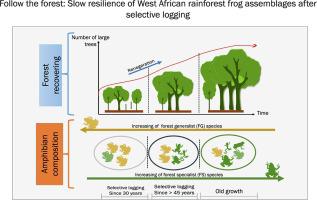Forest Ecology and Management ( IF 3.7 ) Pub Date : 2021-07-10 , DOI: 10.1016/j.foreco.2021.119489 Tokouaho Flora Kpan , Raffael Ernst , Mark-Oliver Rödel

|
Assessing resilience of ecological communities, the ability of species assemblages to return to a previous state following disturbance, is an essential task when designing biodiversity friendly concepts for silvicultural management regimes. However, ecological communities may demonstrate resilience only after long time periods, and long-term data, collected on permanent study sites within standardized sampling frameworks, are scarce. We assessed the resilience of amphibian assemblages to disturbance via selective logging within the largest remaining rainforest in Ivory Coast, the Taï National Park. We analyzed extensive amphibian and habitat data obtained during two major assessment periods > 15 years apart (period P1 = in 2000, period P2 = in 2016–2017) and spanning 45 years post-logging recovery (period P1 = 30 years post-logging). We revisited identical sites and used identical, standardized methodology in both study periods. Forest structure in formerly selectively logged sites slowly recovered towards old growth forest structure over the course of 45 years, with most visible changes occurring between P1 and P2. While species richness and diversity in both old growth and secondary forests remained largely unchanged across the study periods, frog assemblage composition in formerly disturbed sites followed the forest recovery process. Yet, their composition was still distinctly different from old growth forest assemblages. The different levels of resilience over time indicate that the slowest organisms in our system (forest trees) set the pace for the recovery of associated taxa (frogs). Effective post-harvesting restoration schemes need to incorporate these delayed response times. Thus, significantly longer felling cycles than those commonly applied in regular harvesting schemes are needed if the goal is to conserve and restore original forest diversity in logged forest ecosystems.
中文翻译:

跟随森林:选择性采伐后西非雨林青蛙组合的恢复力缓慢
在为林业管理制度设计生物多样性友好概念时,评估生态群落的恢复力、物种组合在受到干扰后恢复到先前状态的能力是一项基本任务。然而,生态群落可能只有在很长一段时间后才能表现出恢复力,而且在标准化抽样框架内的永久性研究地点收集的长期数据很少。我们通过在象牙海岸剩余的最大热带雨林泰伊国家公园内的选择性伐木来评估两栖动物组合对干扰的恢复能力。我们分析了在两个主要评估期(期间 P1 = 2000 年,期间 P2 = 2016-2017 年)和跨越 45 年的采伐后恢复(期 P1 = 采伐后 30 年)期间获得的大量两栖动物和栖息地数据. 我们在两个研究期间都重新访问了相同的站点并使用了相同的标准化方法。在 45 年的过程中,以前选择性采伐地点的森林结构慢慢恢复为古老的森林结构,最明显的变化发生在 P1 和 P2 之间。虽然旧林和次生林的物种丰富度和多样性在整个研究期间基本保持不变,但以前受干扰地点的青蛙组合组成跟随森林恢复过程。然而,它们的组成仍然与古老的森林组合明显不同。随着时间的推移,不同程度的恢复能力表明,我们系统中最慢的生物(林木)为相关类群(青蛙)的恢复设定了速度。有效的收获后恢复计划需要考虑这些延迟的响应时间。因此,如果目标是保护和恢复采伐森林生态系统中的原始森林多样性,则需要比常规采伐计划中通常采用的砍伐周期长得多的砍伐周期。









































 京公网安备 11010802027423号
京公网安备 11010802027423号